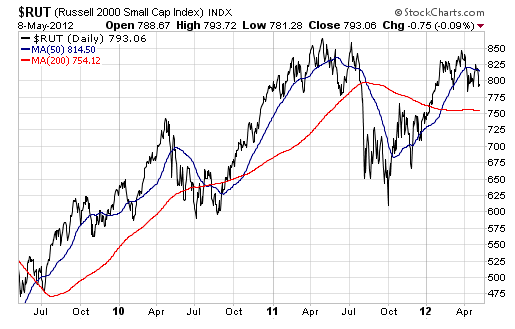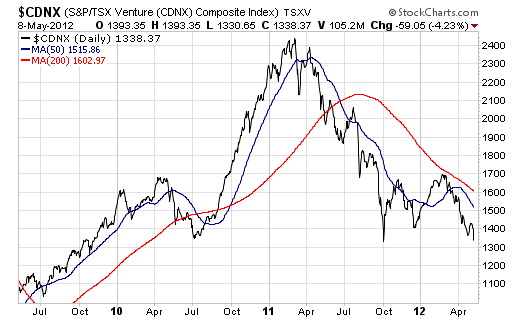They say fortune favors the bold. Fortuna, the Roman goddess of luck, was rumored to reward those who take action and embrace risk.
At times you do have to be bold to make money as a small-cap investor, but up until recently it seemed more like you just needed to be present. This 3-year chart of the Russell 2000 small-cap index shows what I mean. Despite some bumps, small-cap investors have made out pretty well.

However, Mrs. Fortuna is also known to act capriciously, and in recent trading sessions she has brought bad luck to many once glimmering stocks. A string of losing days in the market and a resurgence of turmoil in Europe have made many investors skittish, and the brave are starting to get tested.
By far the worst performing stocks are the junior miners, as evidenced by this ugly chart of the TSX Venture exchange, the best proxy for the junior resource sector.

If you have any exposure to these types of stocks, you likely have some concerns about where they are headed. But if you own them as part of a well-diversified small-cap portfolio you should be breathing just fine.
It's this diversification that keeps small-cap investors brave and standing by their strategy. Investors without strategies are like sailors without navigation systems – left adrift on the ocean until they ultimately perish.
There are four components to a very simple small-cap diversification strategy that I believe lead to outperformance over time (and you don't need to be especially bold to follow through on it):
1) Targeted diversification across multiple industries (i.e., buy into the big positive trends)
2) Diversification across time (i.e., buy in tranches)
3) Diversification in both growth and income stocks
4) Buy when “stupid” prices appear
Naturally, good stock selection is critical. But assuming you are moderately successful with that, the above will ensure you have plenty of upside potential during market rallies, and appropriate downside protection during corrections.
And you need to own only around 15 stocks to make it work. Go much beyond that and the benefits of further diversification essentially disappear.
To show how this can work, here is an excerpt from last week's Small Cap Investor PRO update:
"With 12 of our 15 stocks in positive territory we're sitting on an average gain of 73.5%. Three of our stocks are posting triple digit gains, 7 are up double digits, and two are up single digits. Our two biggest winners are up over 400% and 300%…
…I'm continuing to advocate cautious optimism while I await the volatility that is bound to come sooner or later. Stay diversified, buy stocks in tranches and make sure to keep some money on the side to take advantage of stupid sell-offs when they appear – like they did last summer…
The gains in this portfolio are directly attributed to sticking with a strategy over time, accepting that we'll take some lumps, and not exiting all positions when sell-offs occur.
This has helped subscribers reach a 400% current gain with Allot Communications (Nasdaq: ALLT). And we recently booked a 27% gain after five months when we sold GeoResources (NASDAQ: GEOI), a Bakken oil player that is being bought out.
Of course we've taken some lumps, too. Our gold and silver stocks have been pummeled in recent weeks as the chart I showed above would suggest. But we didn’t buy them all at once, so on average we're up 43% on the three we currently hold.
Broader exposure to oil and gas, industrials, dividend paying, and consumer staples stocks has kept the average portfolio gain trending steadily higher. And those gains support confidence in the strategy to help hold (or buy) beaten-down names.
Things are starting to get interesting in the gold and silver mining space again. Are we seeing “stupid” prices yet? I don't know. But we're getting closer and this is a good time to make a list of names you'd like to own.
Here's to being bold,
Good Investing,
Tyler Laundon, MBA
 Facebook
Facebook
 Twitter
Twitter